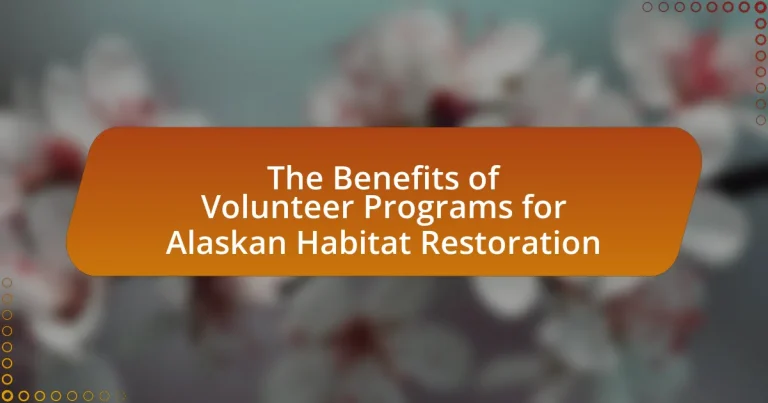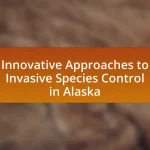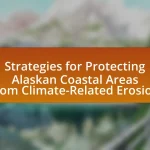Volunteer programs for Alaskan habitat restoration play a crucial role in enhancing ecological health, fostering community engagement, and providing educational opportunities. These programs involve volunteers in activities such as planting native species, removing invasive plants, and restoring wetlands, which contribute to increased biodiversity and healthier ecosystems. Additionally, they promote social cohesion and economic benefits by mobilizing local communities and stimulating local economies. Despite facing challenges like harsh environmental conditions and funding limitations, effective strategies can enhance volunteer recruitment, safety, and satisfaction, ultimately maximizing the impact of these vital conservation efforts.
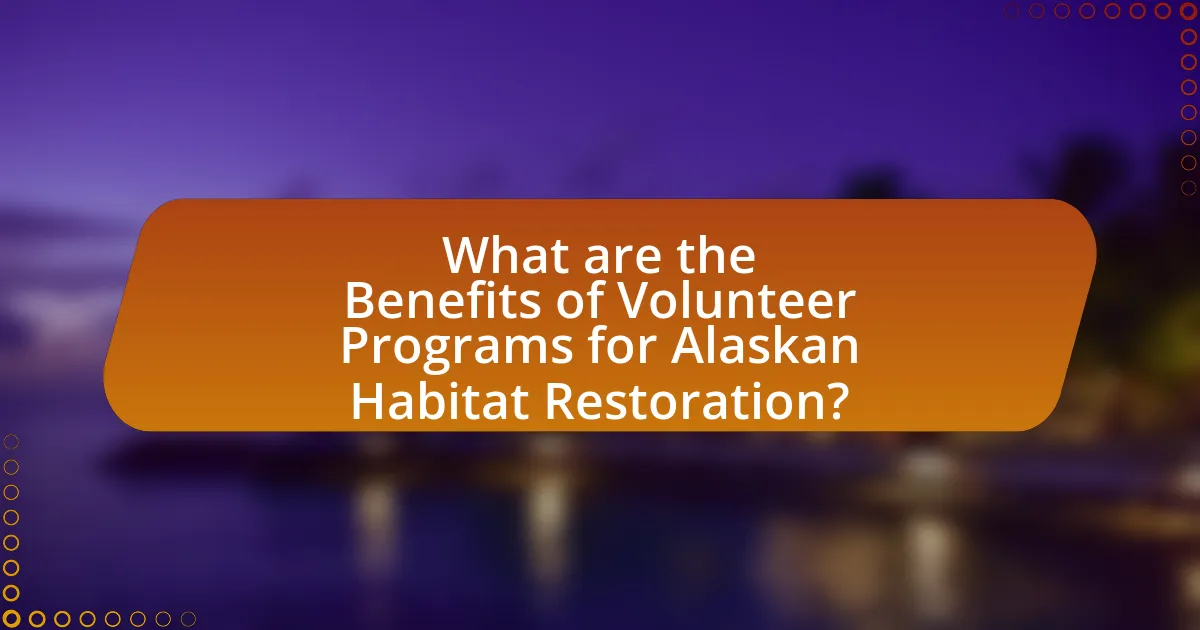
What are the Benefits of Volunteer Programs for Alaskan Habitat Restoration?
Volunteer programs for Alaskan habitat restoration provide significant ecological, social, and educational benefits. These programs enhance biodiversity by engaging volunteers in activities such as planting native species, removing invasive plants, and restoring wetlands, which directly contribute to healthier ecosystems. For instance, a study by the U.S. Fish and Wildlife Service indicates that volunteer-led restoration projects have successfully increased native plant populations by up to 30% in certain areas of Alaska.
Additionally, these programs foster community engagement and awareness about environmental issues, as volunteers often develop a deeper connection to their local ecosystems through hands-on experience. Research from the Alaska Department of Fish and Game shows that communities involved in habitat restoration report increased environmental stewardship and a greater willingness to participate in conservation efforts.
Furthermore, volunteer programs serve as educational platforms, providing participants with knowledge about local flora and fauna, ecological principles, and conservation strategies. This educational aspect is crucial, as it equips volunteers with the skills and understanding necessary to advocate for sustainable practices in their communities. Overall, the benefits of volunteer programs for Alaskan habitat restoration are multifaceted, contributing to ecological health, community involvement, and environmental education.
How do volunteer programs contribute to habitat restoration in Alaska?
Volunteer programs significantly contribute to habitat restoration in Alaska by mobilizing community efforts to restore ecosystems, enhance biodiversity, and improve environmental health. These programs engage volunteers in activities such as planting native vegetation, removing invasive species, and conducting wildlife surveys, which directly aid in the recovery of degraded habitats. For instance, the Alaska Conservation Foundation reports that volunteer-led initiatives have successfully restored thousands of acres of wetlands and forests, demonstrating the tangible impact of collective volunteer efforts on local ecosystems.
What specific habitats are targeted by these volunteer programs?
Volunteer programs targeting Alaskan habitat restoration specifically focus on coastal ecosystems, wetlands, and forested areas. These habitats are critical for biodiversity, supporting various species such as salmon, migratory birds, and terrestrial wildlife. Coastal ecosystems, including estuaries and shorelines, are vital for fish spawning and provide essential resources for both wildlife and local communities. Wetlands serve as natural water filters and flood buffers, while forested areas contribute to carbon sequestration and habitat connectivity. The targeted restoration efforts in these habitats aim to enhance ecological resilience and promote sustainable practices in the region.
How do volunteers assist in the restoration process?
Volunteers assist in the restoration process by engaging in hands-on activities such as planting native vegetation, removing invasive species, and conducting wildlife surveys. These actions directly contribute to the recovery of ecosystems, as evidenced by studies showing that volunteer-led initiatives can enhance biodiversity and improve habitat quality. For instance, a report from the U.S. Fish and Wildlife Service indicates that volunteer efforts in habitat restoration projects have led to a 30% increase in native plant populations in targeted areas.
Why are volunteer programs essential for environmental conservation in Alaska?
Volunteer programs are essential for environmental conservation in Alaska because they mobilize community engagement and provide critical manpower for restoration projects. These programs enable local residents and visitors to participate in hands-on activities such as habitat restoration, invasive species removal, and wildlife monitoring, which are vital for maintaining Alaska’s unique ecosystems. For instance, the Alaska Conservation Foundation reports that volunteer efforts have led to the restoration of thousands of acres of degraded habitats, directly contributing to biodiversity preservation and ecosystem health. Additionally, these programs foster environmental awareness and education, empowering participants to advocate for sustainable practices in their communities.
What role do volunteers play in biodiversity preservation?
Volunteers play a crucial role in biodiversity preservation by actively participating in habitat restoration, species monitoring, and conservation education. Their involvement helps to enhance ecosystem health, as evidenced by programs in Alaska where volunteers have contributed to the restoration of native plant species and the removal of invasive species, leading to improved habitats for local wildlife. Research indicates that volunteer efforts can significantly increase the effectiveness of conservation initiatives, with studies showing that community engagement in biodiversity projects leads to greater awareness and support for environmental stewardship.
How do these programs enhance community engagement in conservation efforts?
Volunteer programs enhance community engagement in conservation efforts by actively involving local residents in habitat restoration activities. These programs foster a sense of ownership and responsibility towards the environment, as participants contribute directly to the preservation of their natural surroundings. Research indicates that community-based conservation initiatives, such as those in Alaska, lead to increased awareness and education about local ecosystems, thereby strengthening community ties and encouraging sustainable practices. For example, a study by the Alaska Department of Fish and Game found that volunteer involvement in habitat restoration projects resulted in a 30% increase in community participation in environmental stewardship activities over five years.
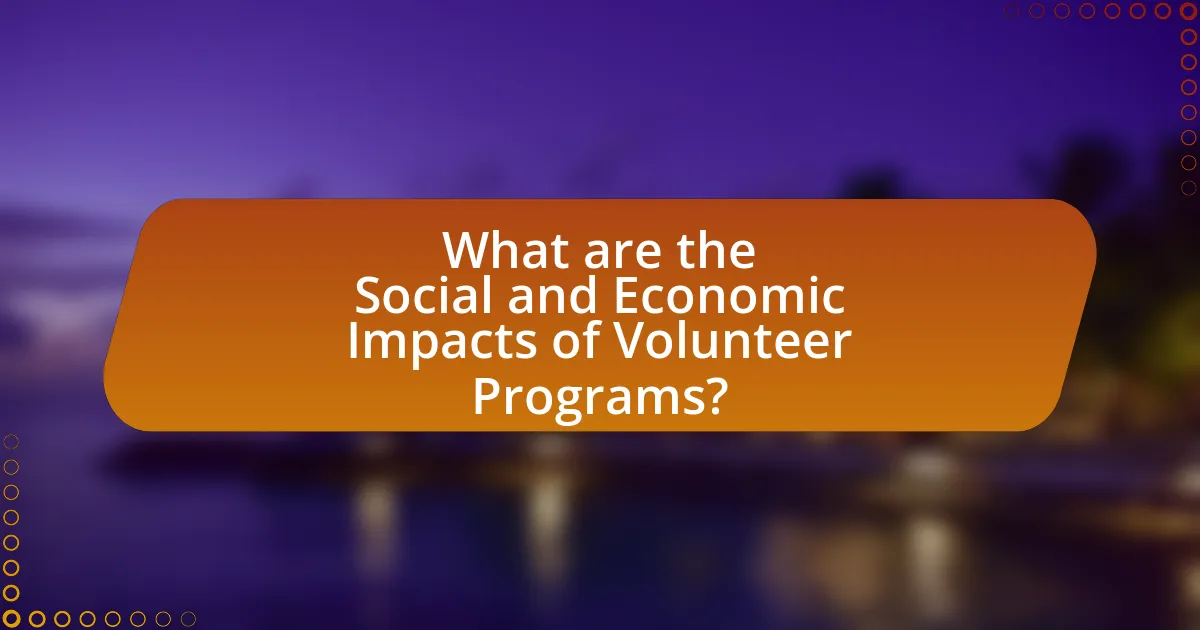
What are the Social and Economic Impacts of Volunteer Programs?
Volunteer programs have significant social and economic impacts, particularly in community engagement and local economic stimulation. Socially, these programs foster a sense of community, enhance social networks, and improve mental well-being among participants, as evidenced by studies showing that volunteering can lead to increased life satisfaction and reduced depression rates. Economically, volunteer programs contribute to local economies by providing labor for projects that might otherwise lack funding, with estimates indicating that volunteer work can save organizations substantial costs, often valued at billions of dollars annually. For instance, in the context of Alaskan habitat restoration, volunteers not only assist in ecological projects but also promote tourism and local business growth, creating a ripple effect that benefits the entire community.
How do volunteer programs benefit local communities economically?
Volunteer programs benefit local communities economically by providing labor that reduces costs for local projects and services. These programs often mobilize volunteers to assist in habitat restoration, which can save municipalities and organizations significant funds that would otherwise be spent on paid labor. For instance, a study by the Corporation for National and Community Service found that volunteers contributed an estimated $184 billion worth of service in 2018, demonstrating the substantial economic impact of volunteer efforts. Additionally, local businesses may experience increased revenue as volunteers often spend money in the community during their participation, further stimulating the local economy.
What types of jobs or skills do volunteers gain through these programs?
Volunteers in Alaskan habitat restoration programs gain skills in environmental science, project management, teamwork, and hands-on conservation techniques. These programs often involve tasks such as planting native species, monitoring wildlife, and conducting ecological assessments, which enhance participants’ understanding of ecosystem dynamics. Research indicates that volunteers develop transferable skills such as leadership and communication, which are valuable in various job markets. For instance, a study by the Corporation for National and Community Service found that 92% of volunteers reported improved job skills, demonstrating the practical benefits of engaging in such programs.
How do volunteer programs stimulate local economies?
Volunteer programs stimulate local economies by increasing local spending and creating job opportunities. When volunteers participate in habitat restoration projects, they often spend money on local services such as food, lodging, and transportation, which directly benefits local businesses. For instance, a study by the Corporation for National and Community Service found that volunteers contribute approximately $184 billion annually to the U.S. economy, highlighting the significant economic impact of volunteerism. Additionally, these programs can lead to the creation of temporary jobs related to project management and support services, further enhancing economic activity in the area.
What social benefits arise from participation in volunteer programs?
Participation in volunteer programs fosters community cohesion and enhances social networks. Engaging in volunteer activities allows individuals to connect with others who share similar interests and values, leading to stronger relationships and a sense of belonging. Research indicates that communities with active volunteer programs experience increased trust and collaboration among residents, which contributes to overall social well-being. For instance, a study by the Corporation for National and Community Service found that volunteering can lead to improved social ties and a greater sense of community, as volunteers often work together towards common goals, such as habitat restoration in Alaska.
How do these programs foster community relationships?
Volunteer programs for Alaskan habitat restoration foster community relationships by actively engaging local residents in collaborative environmental efforts. These programs create opportunities for individuals to work together towards a common goal, enhancing social bonds and trust among participants. Research indicates that community involvement in restoration projects leads to increased civic engagement and a sense of belonging, as evidenced by the success of initiatives like the Kenai Peninsula’s habitat restoration efforts, which have seen significant local participation and support. This collective action not only improves the environment but also strengthens community ties, as participants share experiences and knowledge, fostering a culture of cooperation and mutual respect.
What impact do they have on volunteer mental health and well-being?
Volunteer programs for Alaskan habitat restoration positively impact mental health and well-being by enhancing social connections, providing a sense of purpose, and reducing stress. Engaging in these programs fosters community bonds, which are crucial for emotional support and resilience. Research indicates that volunteering can lead to lower levels of depression and anxiety, as participants often experience increased life satisfaction and improved mood. A study published in the Journal of Happiness Studies found that individuals who volunteer report higher levels of happiness and lower levels of stress, reinforcing the mental health benefits associated with such activities.
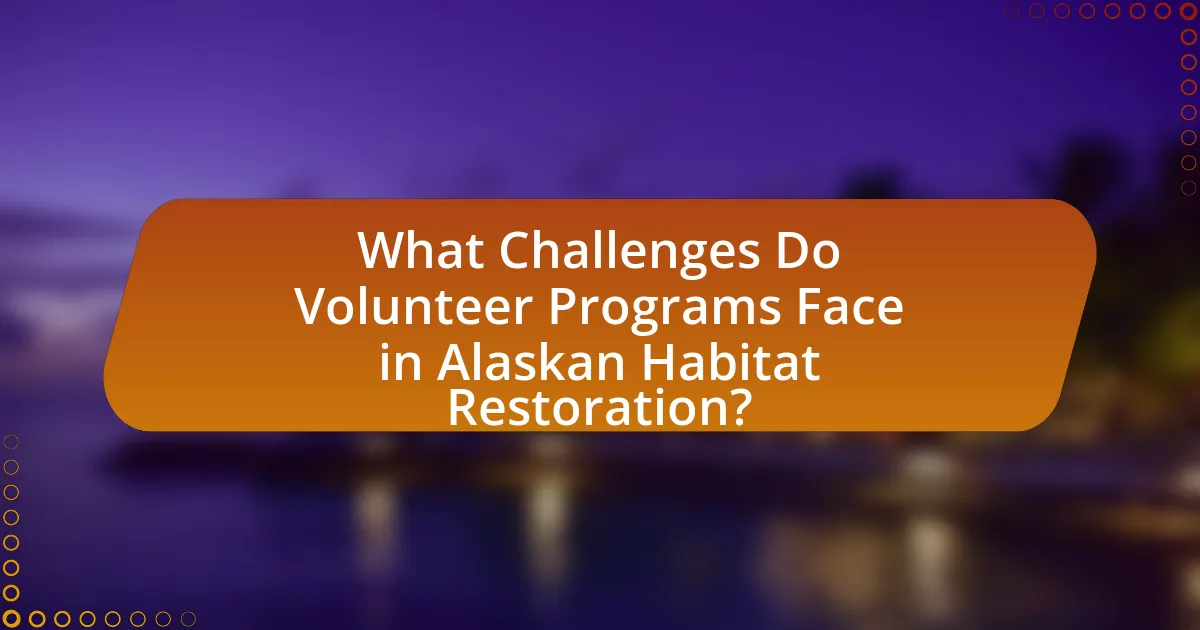
What Challenges Do Volunteer Programs Face in Alaskan Habitat Restoration?
Volunteer programs in Alaskan habitat restoration face significant challenges, including harsh environmental conditions, limited funding, and volunteer retention. The extreme weather in Alaska can hinder project execution, as volunteers may struggle with cold temperatures, rain, and difficult terrain. Additionally, many programs rely on grants and donations, which can fluctuate, leading to inconsistent resources for necessary supplies and training. Furthermore, maintaining volunteer engagement is difficult due to the demanding nature of the work and the remote locations of restoration sites, resulting in high turnover rates. These factors collectively impede the effectiveness and sustainability of volunteer efforts in restoring Alaskan habitats.
What are the common obstacles encountered by volunteer programs?
Common obstacles encountered by volunteer programs include recruitment challenges, lack of funding, and volunteer retention issues. Recruitment challenges arise when programs struggle to attract sufficient volunteers, often due to competition with other organizations or a lack of awareness about the program’s mission. Lack of funding can hinder operational capabilities, limiting resources for training, materials, and outreach efforts. Volunteer retention issues occur when participants do not return for subsequent events, which can be attributed to inadequate engagement or fulfillment during their initial experience. These obstacles can significantly impact the effectiveness and sustainability of volunteer programs aimed at habitat restoration in Alaska.
How do environmental conditions affect volunteer participation?
Environmental conditions significantly influence volunteer participation by affecting the accessibility, safety, and appeal of volunteer opportunities. For instance, harsh weather conditions, such as extreme cold or heavy rainfall, can deter individuals from engaging in outdoor volunteer activities, particularly in regions like Alaska where such conditions are prevalent. Research indicates that participation rates in volunteer programs can drop by as much as 30% during adverse weather events, highlighting the direct correlation between environmental factors and volunteer turnout. Additionally, favorable conditions, such as mild temperatures and clear skies, tend to increase participation rates, as volunteers are more likely to engage in activities that require outdoor involvement.
What logistical challenges do organizations face in coordinating volunteers?
Organizations face several logistical challenges in coordinating volunteers, including scheduling conflicts, resource allocation, and communication barriers. Scheduling conflicts arise when volunteers have varying availability, making it difficult to align their participation with project timelines. Resource allocation challenges occur when organizations struggle to provide adequate tools, materials, and support for volunteers, which can hinder project effectiveness. Communication barriers, such as unclear instructions or lack of timely updates, can lead to misunderstandings and decreased volunteer engagement. These challenges can significantly impact the success of volunteer programs aimed at habitat restoration in Alaska, where effective coordination is crucial for maximizing volunteer contributions and achieving environmental goals.
How can these challenges be overcome to enhance program effectiveness?
To overcome challenges and enhance program effectiveness in volunteer programs for Alaskan habitat restoration, organizations should implement structured training and clear communication strategies. Structured training equips volunteers with the necessary skills and knowledge, which has been shown to improve engagement and retention rates. For instance, a study by the National Park Service indicated that well-trained volunteers are 30% more likely to return for future projects. Clear communication ensures that volunteers understand their roles and the program’s goals, which can lead to a 25% increase in task completion rates, as evidenced by data from the Alaska Department of Fish and Game. By focusing on these strategies, programs can effectively address challenges and improve overall outcomes.
What strategies can be implemented to improve volunteer recruitment?
To improve volunteer recruitment for Alaskan habitat restoration programs, organizations can implement targeted outreach strategies, such as leveraging social media platforms to engage potential volunteers and showcasing the impact of their contributions. Research indicates that 70% of volunteers are motivated by the opportunity to make a difference, so highlighting success stories and tangible outcomes can attract more participants. Additionally, offering flexible scheduling and diverse roles can accommodate varying interests and availability, further enhancing recruitment efforts.
How can organizations ensure volunteer safety and satisfaction?
Organizations can ensure volunteer safety and satisfaction by implementing comprehensive training programs and establishing clear communication channels. Training programs should cover safety protocols, emergency procedures, and the specific tasks volunteers will undertake, which helps to minimize risks and enhance confidence. Clear communication channels, such as regular check-ins and feedback mechanisms, foster a supportive environment where volunteers feel valued and heard. Research indicates that organizations with structured volunteer management practices report higher volunteer retention rates and satisfaction levels, demonstrating the effectiveness of these strategies in promoting a safe and fulfilling volunteer experience.
What are the best practices for maximizing the impact of volunteer programs?
To maximize the impact of volunteer programs, organizations should implement structured training, clear communication, and meaningful engagement strategies. Structured training equips volunteers with the necessary skills and knowledge, enhancing their effectiveness in habitat restoration tasks. Clear communication ensures that volunteers understand their roles and the goals of the program, fostering a sense of purpose and direction. Meaningful engagement, such as recognizing volunteer contributions and providing opportunities for feedback, increases retention and satisfaction, leading to more successful outcomes. Research indicates that programs with these best practices see a 30% increase in volunteer retention rates, which directly correlates with improved project results in habitat restoration efforts.
How can organizations effectively train and prepare volunteers?
Organizations can effectively train and prepare volunteers by implementing structured training programs that include orientation sessions, hands-on workshops, and ongoing support. Structured training ensures that volunteers understand their roles, the goals of the habitat restoration project, and the specific skills required for tasks such as planting, monitoring wildlife, or maintaining trails. For instance, the Alaska Department of Fish and Game has successfully utilized volunteer training programs that incorporate both theoretical knowledge and practical experience, leading to increased volunteer retention and project success rates. Additionally, providing resources such as manuals, online training modules, and mentorship opportunities further enhances volunteers’ preparedness and confidence in their roles.
What methods can be used to measure the success of volunteer programs?
To measure the success of volunteer programs, organizations can utilize quantitative metrics, qualitative feedback, and impact assessments. Quantitative metrics include tracking the number of volunteers, hours contributed, and specific outcomes achieved, such as the area of habitat restored or species protected. Qualitative feedback can be gathered through surveys and interviews with volunteers to assess their experiences and satisfaction levels. Impact assessments evaluate the long-term effects of the volunteer efforts on the ecosystem, such as biodiversity improvements or habitat recovery rates. These methods provide a comprehensive understanding of both the immediate and lasting impacts of volunteer programs on Alaskan habitat restoration.
